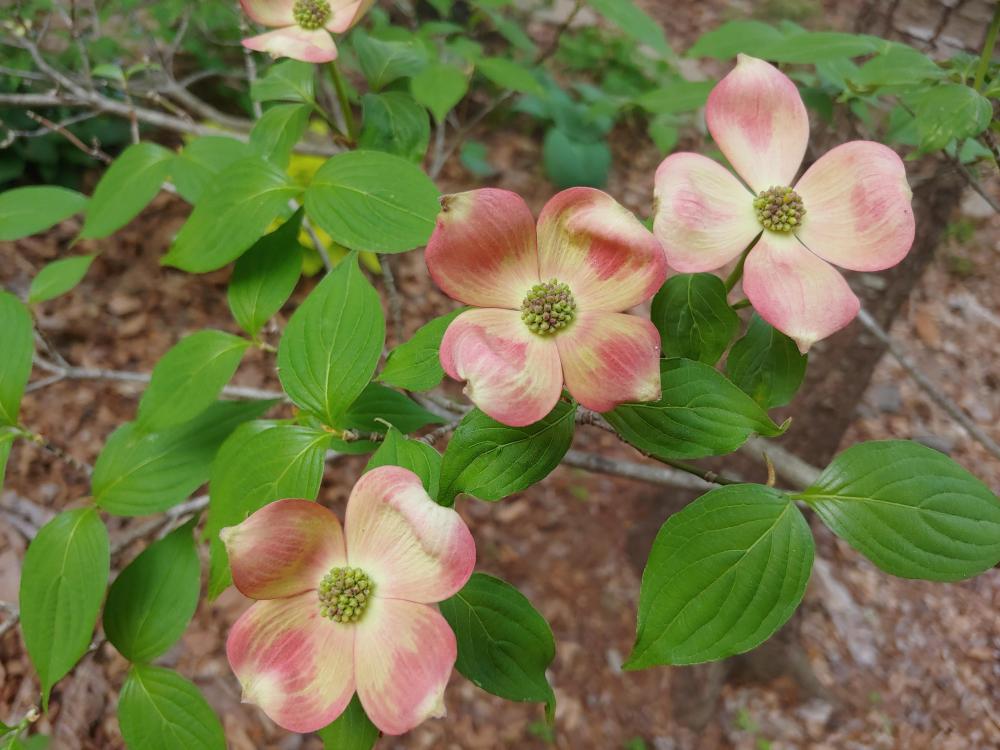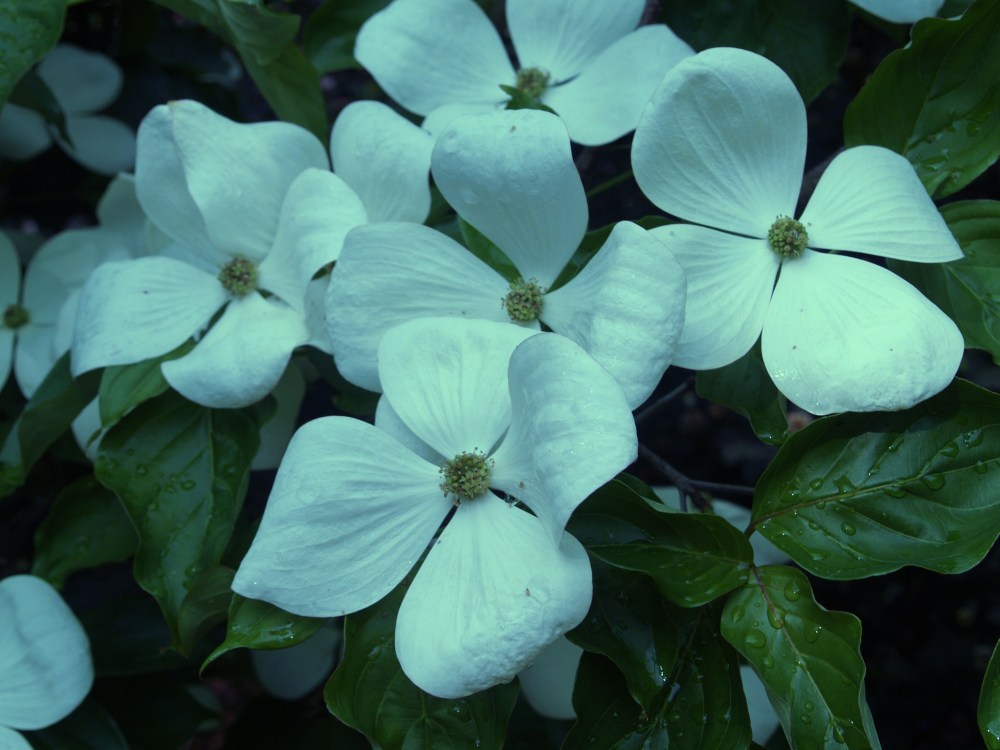A tall, hybrid ‘Stellar Pink’ dogwood (Cornus ‘Rutgan’) towers above the garden, with only a few branches low enough in this low canopy garden for flowers to be seen. When describing this dogwood to visitors, I habitually refer to it as ‘Stellar’ to limit discussion, since the blooms rarely display any more than a slight blush of pink. Until this year (below), and one year some time ago when apparently weather conditions were ideal to keep flowers from immediately fading to white. Still, I expect the newly opened flowers to fade quickly, even in this very shaded spot in the garden. From what I’ve seen, sun or shade doesn’t matter, in the heat or humidity (or whatever the cause) of this area ‘Stellar Pink’ can hardly be called a pink flowering dogwood.

A (supposed) pink flowered Chinese dogwood (Cornus kousa ‘ Satomi’) does much the same, and I’ve seen it with very pink flowers in Oregon, so it is clear that there’s something in our Virginia spring that causes the faded color. I read that newly introduced, improved Chinese dogwoods will flower pink, but I’m a non-believer until I see one in a Virginia garden.

Of course, ‘Stellar Pink’ and ‘Satomi’ are fine trees, both with a blush of pink, but heavy bloomers, and there’s no complaint except they don’t flower the color they’re supposed to. I wouldn’t think of not having them in the garden. Another hybrid dogwood, ‘Venus’ (below), comes true to form with unusually large white flowers, and once I thought this would take over the dogwood market since folks are often taken in by an ostentatious flower display. But, lack of supply, or possibly the over sized blooms are too large so that it is more difficult to come by than when it was first introduced.

So pretty Dave! Thanks! 😀
Had to leave the Satomi at the old house. Didn’t flower much.
Is there a double flowering version?
I get a good number of flowers on the brighter shaded side of Satomi, and few on the deeper shade side. I haven’t seen a double flowered version, but there are always new introductions in the works.
Super stunning photos! Thanks for sharing, as Dogwood blooms are usually shortened in my garden by rains …. Ugh …. a double-edged sword.
Now that I am reading this, these flowers must be long gone.
I just planted six ‘Eddie’s White Wonder’ last week, and the faded flowers were still haning one, even with the foliage. I sort of enjoy working with dogwood because, although we grew them at the farm, I did not grow any at home. They really dislike the aridity of the climate just a few miles away.
I’ve seen that dogwoods grow quite differently on the west coast, even in the cooler northwest. It seems dogwoods (and azaleas) prefer heat and humidity.
Dogwoods are not so happy in the Santa Clara Valley because of the lack of humidity. Many of the dogwoods here are ‘Eddie’s White Wonder’, which happens to be more tolerant of aridity. The more popular cultivars here are probably different from what is popular in the Northwest.
unsurprisingly, I’ve found the Pacific dogwood objects to our humidity, but hybrids with a mix of Eastern, Pacific, and Chinese dogwoods thrive here.
Well, that used to be the justification for hybridization and breeding, to combine favorable characteristics of various varieties or species.
Still, I’m curious how Stellar Pink was developed by Rutgers U. in New Jersey. Ir could not have been pink in the field.
Not too long ago, I wrote about all the new varieties of California poppies that I dislike because they are all sorts of weird colors. (Orange is so excellent that there is no way to improve on it.) The weird colors are natural variants that were selected. I don’t know how it was done because it never worked for me when I collected seed from the very rare creamy white poppies growing wild. I would guess that they did it through several generations, by taking seed from the variants, and taking seed from their babies that were like the parents, . . . . and repeating the process for a few generations. As if that does not already seem like too much work, it would be even more work and take a few centuries to do the same with dogwoods. Yet, the ‘pink’ dogwoods were likely selected from variants found in the wild. When I was very young, I remember learning that wild dogwoods in Western Pennsylvania bloomed either white or pink.
I have a young white dogwood, can’t remember the name that seems really stressed this year. The pink one is doing fine. I have a picture of it and was wondering if I could get some insight on what the problem is. Leaves became narrow and a little curled. Not happy.
Linda, please email a photo to [email protected] The excessive amount of rainfall in the pasts year has been a problem for many dogwoods. Small and curled leaves sounds very much like a problem with wet soil. It is difficult to forecast if trees will recover.